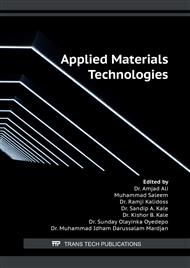[1]
M. Sohaib, F. M. Anjum, and M. S. Arshad, Postharvest intervention technologies for safety enhancement of meat and meat based products - A critical review, J. Food Sci. Technol. 53 (2016) 19–30.
DOI: 10.1007/s13197-015-1985-y
Google Scholar
[2]
J. M. Jay, Modern Food Microbiology, Sixth Ed., Gaithersburg, Maryland: Aspen Publishers, Inc, (2000).
Google Scholar
[3]
L. Fu, A. Wang, Z. Huaiwei, Q. Zhou, F. Chen, W. Su, A. Yu, Z. Ji, Q. Liu, Analysis of chicken breast meat freshness with an electrochemical approach, J. Electroanal. Chem. 855 (2019) 113622.
DOI: 10.1016/j.jelechem.2019.113622
Google Scholar
[4]
N. Wideman, C. A. O'Bryan, and P. G. Crandall, Factors affecting poultry meat colour and consumer preferences - A review, Worlds. Poult. Sci. J.72 (2016) 353–366.
DOI: 10.1017/s0043933916000015
Google Scholar
[5]
R. Quevedo, E. Valencia, G. Cuevas, B. Ronceros, F. Pedreschi, and J. M. Bastías, Color changes in the surface of fresh cut meat: A fractal kinetic application, Food Res. Int. 54 (2013) 1430–1436.
DOI: 10.1016/j.foodres.2013.10.006
Google Scholar
[6]
D. Cornforth, Color — its basis and importance, in : A. M. Pearson, T. R. Dutson (Eds.), Quality Attributes and their Measurement in Meat, Poultry and Fish Products, Springer, Boston, MA, 1994, p.34–78.
DOI: 10.1007/978-1-4615-2167-9_2
Google Scholar
[7]
Kemin, The colour of meat | Kemin Food Technologies Blog | Kemin Europe, 2019. https://www.kemin.com/eu/en/blog/food/the-colour-of-meat (accessed Oct. 25, 2021).
DOI: 10.21748/xfuv8295
Google Scholar
[8]
L. Qiaoyi, X. Yanling, Y. Wenlong, H. Junsheng, and L. Huan, Study on Color Analyzer based on the Multiplexing of TCS3200 Color Sensor and Microcontroller, International Journal of Hybrid Information Technology. 7 (2014) 167–174.
DOI: 10.14257/ijhit.2014.7.5.15
Google Scholar
[9]
M. Bougrini, K. Tahri, Z. Haddi, Nezha El Bari, E. Llobet, N. Jaffrezic-Renault, B. Bouchikhi, Aging time and brand determination of pasteurized milk using a multisensor e-nose combined with voltammetric e-tongue, Mater. Sci. Eng. C. 45 (2014) 348–358.
DOI: 10.1016/j.msec.2014.09.030
Google Scholar
[10]
G. Peiyuan, B. Man, Q. Shiha, and C. Tianhua, Detection of meat fresh degree based on neural network, in : Proc. 2007 IEEE Int. Conf. Mechatronics Autom, ICMA (2007) 2726–2730.
DOI: 10.1109/icma.2007.4303989
Google Scholar
[11]
M. Rivai, F. Budiman, D. Purwanto, and J. Simamora, Meat freshness identification system using gas sensor array and color sensor in conjunction with neural network pattern recognition, J. Theor. Appl. Inf. Technol. 96 (2018) 3861–3872.
Google Scholar
[12]
E. Yalçınöz, Şelale and Erçelebi, Heat-induced degradation kinetics of monomeric anthocyanins and color of pomegranate (punica granatum L.) Concentrate, Int. Sci. Publ. 5 (2017) 471–483.
Google Scholar
[13]
C. C. Yang and M. S. Chinnan, Modeling of Color Development of Tomatoes in Modified Atmosphere Storage, ASABE (1987) 548–553.
Google Scholar
[14]
D. A. Nugroho, L. Sutiarso, E. S. Rahayu, and R. E. Masithoh, Utilizing Real-Time Image Processing for Monitoring Bacterial Cellulose Formation During Fermentation, Agri. Tech. 40 (2020) 118–123.
DOI: 10.26656/fr.2017.6(1).093
Google Scholar
[15]
G. Boronkay, Colour Conversion Centre,, Retrieved on 2021-10-31, 2013. http://ccc.orgfree.com/.
Google Scholar
[16]
A. Asropi, N. Bintoro, J. N. W. Karyadi, S. Rahayoe, and A. D. Saputro, Kinetika Perubahan Sifat Fisik dan Kadar Tanin Biji Sorgum (Sorghum Bicolor L.) Selama Perendaman, Agri. Tech. 39(3) (2019) 222–233.
DOI: 10.22146/agritech.42610
Google Scholar
[17]
M. Estévez, Oxidative damage to poultry: From farm to fork, Poult. Sci. 94 (2015) 1368–1378.
DOI: 10.3382/ps/pev094
Google Scholar



